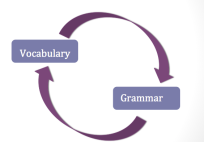In our last post, we described the role of grammar journals. In addition to helping students individualize their grammar practice in a meaningful context, the grammar journals fostered greater awareness of how vocabulary and grammar work together on a continuum. In this post, we look at the same thing, but starting on the vocabulary side.
In our program, we implemented vocabulary journals to encourage production of new words in writing. Students were assigned to write sentences with target vocabulary, but many of their initial attempts fell short:
*Books are worthy sources of human.
*I have improved extensive knowledge when I am taking English classes.
*My English has fostered a lot since I have studied at Lone Star College.
*If you exceed exercise, it can be dangerous to your health.
These examples showed us that our students were struggling, unsure of how to apply the word to an appropriate context, uncertain of how to combine it with other words. They shed light a major problem that students were having, and it wasn’t just vocabulary. It also involved grammar.
Paul Nation (2001) notes that word knowledge goes far beyond a word’s meaning. A student may grasp the meaning of a word, for example, but may still produce sentences showing less understanding of its grammatical features, related parts of speech, appropriate context and register, and collocations.
To solve this problem, we decided to embark on a new approach. In a high-intermediate writing class, students were introduced to a set of vocabulary words for a process essay on achieving a career goal, such as expertise, practical, operate, and entrepreneur.
Rather than giving students a list of individual words for their journal assignment, we chose collocations and lexical chunks which included the target vocabulary, embedding grammar and syntax within the phrases:
| Directions: Use the phrases below for your next vocab journal. Add words before and after the phrase. |
|
The responses were eye-opening:
- He has expertise in fixing machines. Now he is the best mechanic of the company.
- The president Obama came up with a plan to help immigrants.
- He turned a good idea into a good essay.
- My close friend, who has practical experience in taking care of patients, helped me take care of my grandmother.
- My uncle is a successful entrepreneur; he has almost 12 nail salon in Texas.
- My friends currently operate a small business.
- Smartphones are a remarkable accomplishment in this generation.
- An MBA is vital to becoming a manager.
Our sense was that the chunks were bridging the gap between vocabulary and grammar, helping students to produce more meaningful sentences. The lexical chunks gave them “an idea of what to write about,” as one student noted. By scaffolding grammatical accuracy within the chunks—gerunds after prepositions, separable and inseparable phrasal verbs, word order and word forms, article and preposition usage—students could attend to meaning exclusively, the principal aim of a vocabulary journal.
We spent 10-1 5 minutes choosing our target phrases, often consulting www.just-the-word.com to select relevant collocations, but we ended up spending far less time grading the grammatical and syntactical errors that arose from working with a list of individual, decontextualized words.
5 minutes choosing our target phrases, often consulting www.just-the-word.com to select relevant collocations, but we ended up spending far less time grading the grammatical and syntactical errors that arose from working with a list of individual, decontextualized words.
By focusing on “the grammar of the phrase,” grammar and vocabulary became parts of the same continuum. Our students’ learning became more efficient, and their knowledge of a word broadened, not through studying rules, but through using language.
Categories: ELT

Awesome Alice-the-Kid.
LikeLike